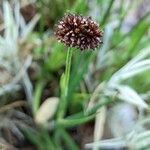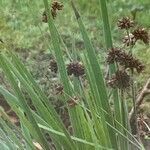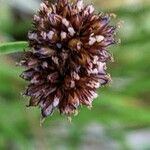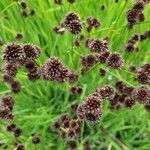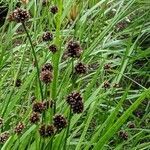Rhizomatous; stem 2–6 dm, flattened; lvs mostly crowded below, the larger ones 10–40 cm × 1.5–6 mm, all equitant; blade with scattered, irregular, partial or complete partitions; heads few, many-fld, 1+ cm thick, mostly dark; fls axillary to evident, hyaline-scarious bracts but not prophyllate; outer tep 2.5–4 mm, acuminate, inner a little shorter and often a little wider and less pointed; stamens 3 (in ours); fr incompletely 3-locular; seeds 0.4–0.6 mm, apiculate at both ends; 2n=20. Wet places; widespread in the w. cordillera, disjunct in Ashland Co., Wis., Mich., and along the Delaware R. in N.Y. Ours is var. ensifolius.
Loosely tufted or forming open colonies, less frequently densely tufted; rhizome slender, ± far-extending. Stems 15-70 cm high, laterally compressed, almost winged at lower nodes, cauline leaves 2-3. Leaves ensiform, ± curved, ± flat, blue-green, longitudinal and transverse septa visible externally, often incomplete. Inflorescence of 1-3 large, many-flowered, usually blackish, globose clusters, causing taller stems to incline. Tepals 2.5-3 mm long, all ± equal, acute to acuminate. Stamens 3-6. Capsule c. 3 mm long, > tepals, oblong, shortly mucronate, dark brown to black.
